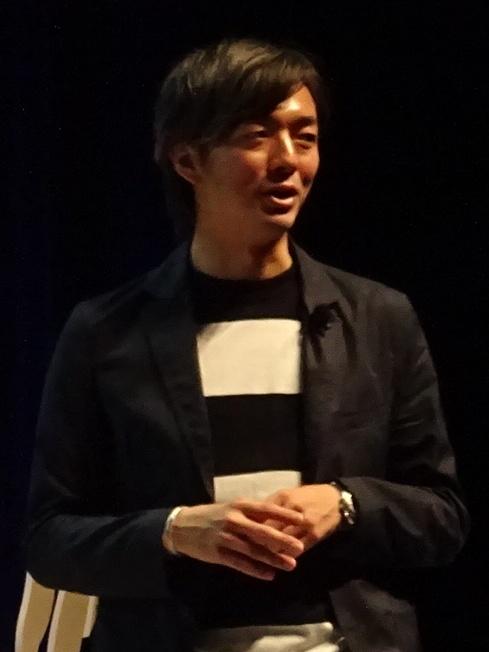- Events
- Awards

The 2017 Cannes Lions International Festival of Creativity, now in its sixty-fourth year, took place June 17-24 in the French resort of Cannes. The Hakuhodo Group has presented a seminar at the festival every year since 2013; it’s become something of a tradition. This year’s seminar was on the mouthwatering subject of “Appetite Creativity.” The three speakers kept the audience spellbound with their fast-paced repartee on creative ways to catch people’s attention as you might stimulate their appetite. Here’s a summary of their presentation.
Date: June 18, 2017 at 12:00-12:45 p.m.
Topic: Appetite Creativity
Speakers:
Haruko Minagawa, International Market Design Division, Hakuhodo / The Institute of Media Environment, Hakuhodo DY Media Partners
Takahiro Hosoda, TBWA_Hakuhodo
Kazuaki Hosoda, Hakuhodo Kettle

The Japanese are exposed to three to four thousand ads and company messages a day, data indicates, of which 98 percent are ignored. People are already gorged with information, and sending out a brand message is like trying to get them to eat an extra dish. We therefore need to stimulate their appetite with a dash of creativity. We need to carefully cultivate a desire to know more about the brand, try the service, own the product.
Today, when advertising techniques are constantly evolving, it’s tempting to try to convey the perfect message. But the perfect message could end up depriving the audience of the chance to use their imagination. The perfect message isn’t in fact perfect at all; imperfection is a lot more intriguing. “Imperfection creates the perfect appetite” may be the clue we’re looking for here.
Here are five tips on how the advertising industry can create an appetite for things in this day and age.

Five Tips for Achieving Imperfection
1. Limit the experience.
The smell of bread being baked or eel being broiled, the sizzle of meat on the grill or Chinese food in the wok — each has the power to whet the appetite. Eating is an all-round experience that involves all five senses. Only getting a whiff or hearing the sizzle of the food makes you want the full sensory experience.
If for example you try to explain the technology behind a product simply by demonstrating it, people won’t see what the big deal is. Instead, focus on the most fascinating thing about the technology and get people to experience that. That limited, imperfect experience will stimulate their desire for the full experience and lead to understanding.
2. Limit information.
Once the aromas and sounds issuing from the restaurant have lured you in, you look at the menu. High-end restaurants tend to have text-only menus, and the dishes that appear on them are carefully named to get your imagination going.
Imperfect information stimulates the imagination. The advertising toolbox is no longer restricted to words and photos. Computer graphics are now incredibly sophisticated, and 4K and 8K technologies have become the norm. There’s VR, along with 4D theaters that deliver a multisensory experience. But no video technology can match the human brain. So trust in the power of the theater of the mind. Next time you’re tempted to try VR for something, step back and think twice. Limiting information stimulates the imagination
3. Limit the senses.
Many restaurants take care to eliminate external distractions with dimmed lighting and a well-designed layout. Creating an ambience that lets diners concentrate solely on the food and conversation heightens the senses.
In this age of information overload, first you need to create an environment where people are going to pay attention to the brand message. You need to shut out all the noise so that only the brand’s voice can be heard. Purposely create an imperfect, inconvenient environment for the audience. As long as if it comes with attractive content, they will gladly take the plunge. Limiting the senses has an immersive effect
4. Limit predictability.
At restaurants in Japan, instead of ordering a predictable full-course meal you can order omakase, which means leaving everything up to the chef. With omakase, you’re constantly wondering what’s going to come next. A chef serving omakase, having sized up the customer, wrenches the meal from the context of the menu.
Ad technology now makes it possible to target your message to a T and deliver it to your audience completely in context. The world abounds in content optimized to each individual. But for that very reason content wrenched from the advertising context is all the more potent. It piques people’s curiosity.
5. Limit the ideal.
Our ultimate favorite food is mom’s home cooking. We never tire of it day after day, though neither the ingredients nor the cooking utensils nor the tableware can hold a candle to those in a fancy restaurant. It’s downright imperfect by comparison. But it seems the things we’re most fond of are all imperfect. People aren’t looking for perfection. They love the imperfections of real life. And that’s exactly what’s happening in advertising today. Advertising used to be about showing people the ultimate ideal, but now, conversely, there’s a trend toward celebrating human imperfection. Limiting the ideal wins people’s sympathy.
With advances in advertising technology, we’re now expected to achieve perfection. But the kind of creativity that arouses people’s desires is rooted in imperfection. We should cherish the imperfect, the inexplicable, the mysterious. We should focus on that indefinable something that engrosses people, because there may lie the key to the future of creativity.

Senior Researcher, The Institute of Media Environment, Hakuhodo DY Media Partners















